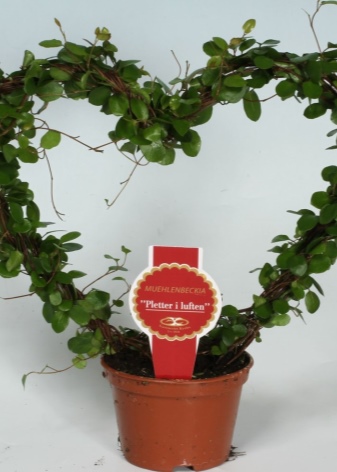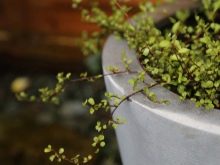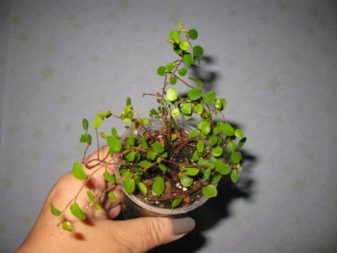Mühlenbeckia: description, types and cultivation

For many years, ornamental plants have been indispensable companions of people. Exotic flowers not only decorate apartments, offices and social facilities, but also help purify the air. On the shelves of specialized stores, you can see a huge number of indoor flowers, which differ in appearance, flowering period and country of growth. For many years, indoor evergreen vines have enjoyed a high level of popularity, which enable designers to create unusual green sculptures and decorations at home. One of the brightest representatives of climbing indoor plants is muhlenbeckia.


Specific traits
Mühlenbeckia is an evergreen plant that belongs to the buckwheat family. This flower is native to New Zealand and Australia. Botanists have more than 25 species of this plant, the size of the shoots of which ranges from 15 cm to 3 meters.
The highly branching and slender stems of the flower are covered with brownish-red bark.
Short-petiolate leaflets have a regular sequence and can be oval, cordate, wedge-shaped or ovoid.

Inflorescences are collected in a brush and are located in the axils. The size of one flower does not exceed 5 mm, and the color can be yellow-green or white. The flowering period begins in early August and ends at the end of the month.
The seed is collected in a spherical seed box.
Due to the fact that the flower has a superficial root system, it is necessary to choose shallow pots of large diameter for planting.

The main feature of the flower is a low level of susceptibility to fungal and viral diseases. In rare cases, the flower can be damaged by earthworms and spider mites. Improper care and poor quality of the potting mix can lead to the death of Mühlenbeckia.
Designers use this plant as an ampelous flower or as a vine climbing on an established support.
The plant not only purifies the air and decorates the room, but also has a beneficial effect on the emotional state of all family members.



Varieties
Biologists identify several of the most popular types of flowers, which differ only in the size of the sheet plate:
- large-leaved - large leaves;
- microfilla - medium leaves;
- nano - small leaves.



At home, experts recommend growing confused muhlenbeckia, the length of the shoots of which can be several meters. A round leaf blade has a size of no more than 15 mm and is located on short petioles. Small inflorescences are formed along the entire length of the stems.
An interesting fact - in nature, there is a flat-headed muhlenbeckia, in which, instead of a leaf plate, ribbon-like jointed shoots are formed. This variety is rarely used in interior decoration.

Care features
Mühlenbeckia is an unpretentious plant, the care of which will not cause difficulties even for novice flower growers.
To create comfortable conditions for the plant for growth and development, it is necessary to provide a high level of illumination without direct sunlight on the flower. Experts recommend placing flower pots on windowsills that face west or east.

A comfortable summer temperature regime for a plant is in the range from + 22 degrees to + 24 degrees Celsius.At higher temperatures, the leaf plate begins to turn yellow and wilt.
In winter, the plant is in a dormant phase and needs a lower temperature regime at +10 degrees Celsius. During the wintering period, the flower can shed part of the deciduous cover.


An evergreen plant needs regular and timely watering. The nutrient substrate must always be kept moist. Young flower growers need to avoid waterlogging of the soil or stagnant water, which can provoke the development of putrefactive processes and soil acidification. During the dormant period, watering the flower can only be done after the top layer of the earth has completely dried out.
For irrigation it is necessary to use only settled water at room temperature.
In order to prevent Mühlenbeckia from drying out, it must be regularly sprayed in rooms with low humidity levels.

For planting evergreen vines, preference should be given to slightly alkaline or acidic soil mixtures. When self-production of nutrient soil, it is necessary to combine sheet, clay-sod and peat soil in equal proportions. The prepared soil should be loose and allow water and air to pass through well. In specialized stores, you can buy ready-made soil substrates. A thick layer of drainage material will help to avoid rotting of the root system.
In the summer, during rapid growth and a set of green mass, it is necessary to feed the flower with mineral fertilizers for deciduous plants 1 time in 14 days.


Every year at the beginning of spring, it is necessary to transplant the plant into a new flower container. Due to the presence of a delicate and thin root system, the earthen lump together with the roots must be carefully transferred into a prepared pot with a larger diameter.
At the end of August, it is advisable to carry out sanitary pruning, which involves the removal of dry processes and inflorescences. Experts recommend shortening a small number of young shoots. This procedure will provoke the development of lateral shoots and make the plant more lush and elegant.

The main mistakes when growing muhlenbeckia:
- lack of peduncles - violation of the irrigation and lighting regime;
- decay of the root system - excessive watering and lack of a drainage layer.
Reproduction
To get a new plant, you can use the following breeding methods:
- dividing the bush;
- cuttings;
- rooting of branches;
- seeds.
Dividing a bush is the most common and easiest way to get a new plant. During the spring transplant, it is necessary to divide the mother bush into the required number of parts and root them in new flower pots.


For seed propagation of a flower, experts recommend purchasing planting material in specialized stores. Purchased seeds have a higher germination rate.
If it is impossible to purchase planting material, experienced gardeners recommend collecting ripe seeds on their own and dry them at room temperature. These seeds can be used for 3 years.
Planting seed should be carried out in small containers with a sand and peat mixture. The seeds should be laid out on the surface of the soil and the soil should be abundantly moistened with a spray bottle. To create a greenhouse effect, it is advisable to cover the pots with plastic wrap. Novice growers should remember to ventilate the container and moisten the soil. Only after the appearance of the first shoots can the film cover be removed. After the formation of the fourth sheet, experts recommend picking.


Many indoor plant lovers use rooted petioles to get a new flower. To obtain planting material, it is necessary to cut off shoots at least 10 cm in size from the mother bush with a sharp tool in the spring or summer and put them in water.After the formation of the root system, it is necessary to root the shoots in the nutrient soil.
Breeders recommend planting at least 3 shoots in one flower pot.
A less common method for obtaining planting material is by rooting branches. To implement this method, you need to choose a healthy and strong stem and sprinkle a small part of it with earth. After the emergence of the root system, you can separate the process from the mother bush and transplant it into a new pot.


You will learn more about growing muhlenbeckia in the video below.























The comment was sent successfully.